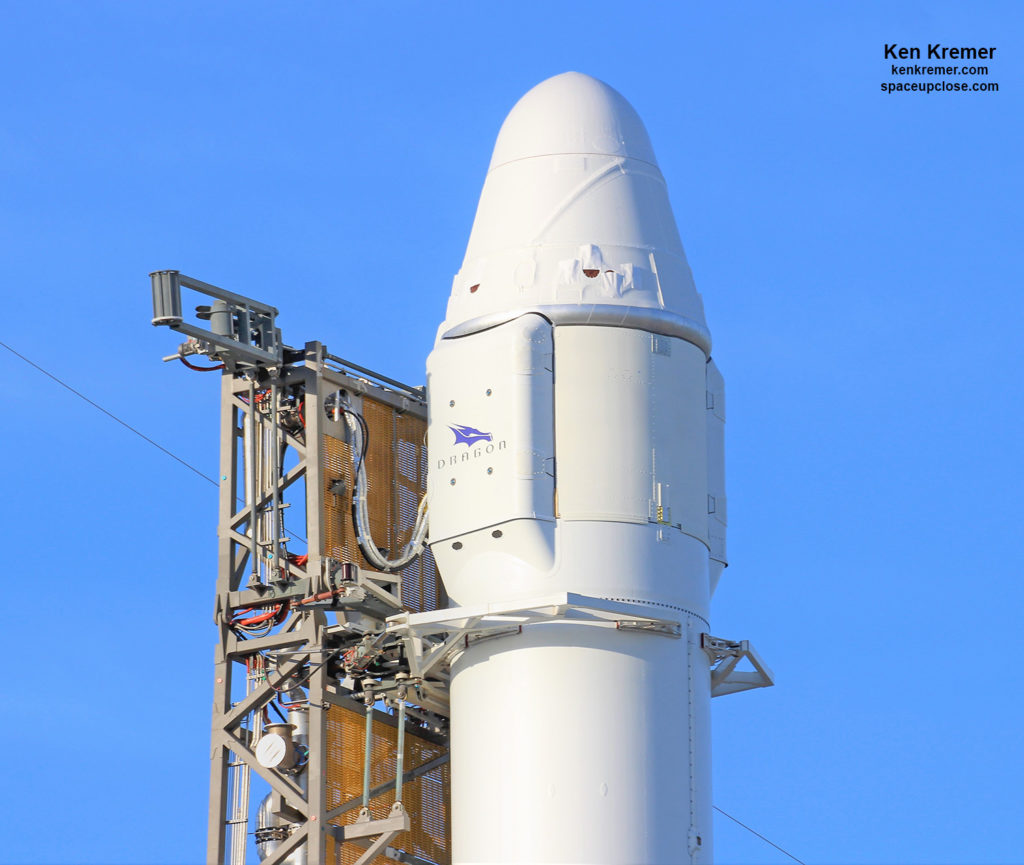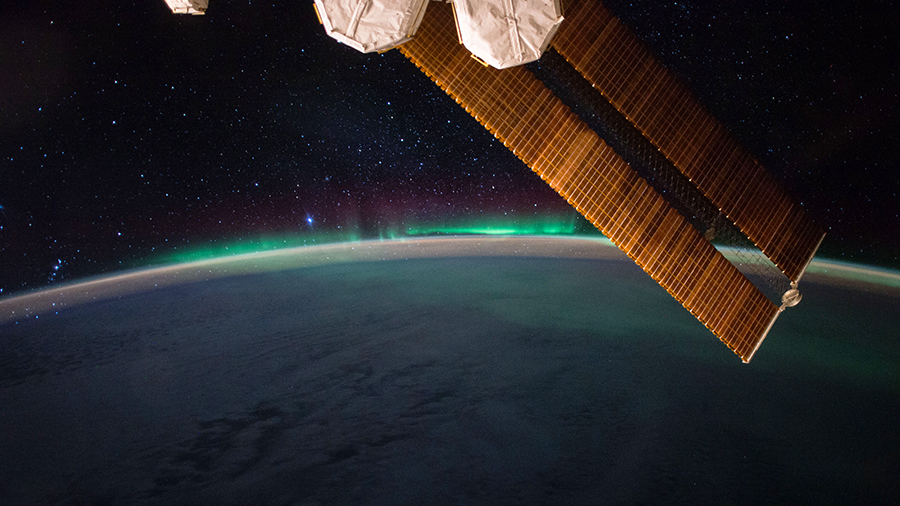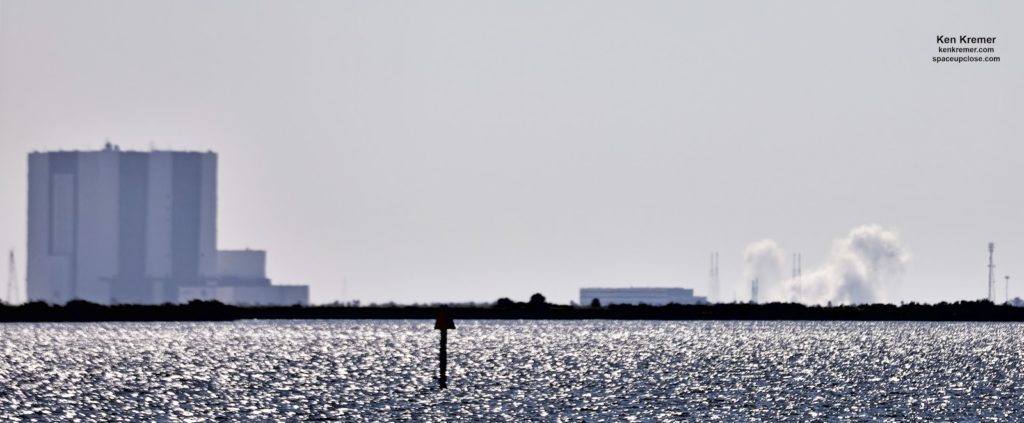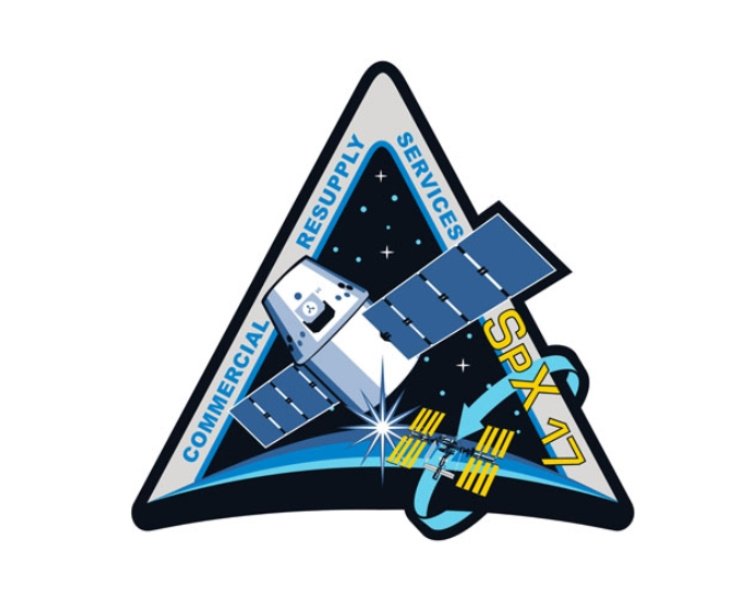 |
|
The
International Space Station photographed by Expedition 56 crew members from a Soyuz spacecraft after undocking on Oct. 4, 2018. Credit: NASA/Roscosmos |
Ken
Kremer — SpaceUpClose.com &
RocketSTEM – 30 April 2019
TITUSVILLE, FL – NASA
officials today postponed the planned May 1 launch of a SpaceX Dragon cargomission to the International Space Station (ISS) by at least 48 hours after discovering an electrical power
problem caused by a failed power distribution component on the orbiting lab complex yesterday April
29 that must be fixed first to ensure the commercial craft can be berthed successfully. Note: Story updated with further details
NASA asked SpaceX to stand down from
Wednesday’s planned overnight liftoff of their Falcon 9 rocket carrying the robotic
Dragon CRS-17 spacecraft while engineers work to troubleshoot and resolve the
power distribution issue that has impacted the
station’s Main Bus Switching Units (MBSU) ability to distribute power to two of
the eight power channels on the station after the MBSU 3 unit failed.
The two channels impacted
with lost power from the failed MBSU 3 component were channels 3A and 3B.
“NASA
has requested SpaceX
move off from May 1 for the launch of the company’s 17th commercial resupply
mission to the International Space Station,” NASA
officials announced in a statement released at midday today, April 30.
“The
earliest possible launch opportunity is no earlier than Friday, May 3.”
SpaceX
and NASA now targeting 3:11 a.m.
EDT (0711 GMT) Friday, May 3 as the earliest possible date for the Falcon 9 rocket launch of the unpiloted Dragon
CRS-17 cargo ship from Space Launch Complex 40 at Cape Canaveral Air Force
Station in Florida.
NASA emphasized that there was no danger to the station or the six person crew of astronauts and cosmonauts on board at this
time.
“There are no immediate concerns for the crew or the station.”
Multiple sources told Space UpClose yesterday that the launch was
very likely to be delayed by at least two days after the power glitch was discovered
Monday morning April 29.
Engineers on the Flight Investigation Team (FIT) at NASA’s Johnson Space Center, Houston, Tx are working diligently to come up with a viable plan to successfully
resolve the stations power distribution problem.
The
Main Bus Switching Units (MBSU) purpose is to feed electric power generated by
the solar arrays to all stations systems via the eight power channels.
The MBSUs have failed previously aboard the station and been replaced
using the robotic arm –
via an operation dubbed Remove and Replace (R & R).
MBSU2 was replaced robotically by ground team operators back in
May 2017 for example.
However the robotic arm must have two functioning redundant power
sources per station operating rules in case one channel fails during use – such
as to grapple the Dragon cargo ship. Hence the launch delay.
“On April 29, the
space station team identified an issue with one of the station’s Main Bus
Switching Units that distributes power to two of the eight power channels on
the station.”
Thus 2 days is the minimum delay, and no one should be surprised
if further delays are necessary as the repair plan is developed as quickly and
safely as possible and implemented with a hopefully successful outcome.
Weather forecasters predict 60% chance of acceptable weather at
the 3:11 a.m. ET launch time on May 3, down from 80% GO for May 1.
NASA hopes to repair the failed power unit component and restore
full power by using the stations Canadian-built Canadarm2 robotic arm rather than sending
a team of space walking astronauts outside for the job.
“Teams are working on a plan to robotically replace the failed
unit and restore full power to the station system,” NASA elaborated today.
NASA initially announced Monday that teams had found a power issue
and were troubleshooting to determine root cause as well as determining of the
then planned May 1 SpaceX launch would be impacted.
“Monday morning, teams identified an issue
with the International Space Station’s electrical power system and are working
to identify the root cause and restore full power to the system,” NASA stated
in a blog post Monday, April 29.
“There are no immediate concerns for the crew
or the station. An issue is being worked with a Main Bus Switching Unit (MBSU)
that distributes electrical power to two of the eight power channels on the
station. Flight controllers have been working to route power through the
remaining six power channels. Electrical power generated by the station’s solar
arrays is fed to all station systems through these power channels. Discussions
are underway to determine any impacts to SpaceX’s CRS-17 cargo resupply mission
targeted for launch May 1.”
The Dragon CRS-17 cargo freighter will carry over
2.7 tons of science experiments, research gear, crew supplies and hardware to
the orbiting laboratory to support the Expedition 59 and 60 crews for
the 17th mission under NASA’s Commercial Resupply Services (CRS) contract.
“The Expedition 59 crew will welcome Dragon when it
arrives …. carrying nearly 5,500 pounds
of cargo.”
Canadian Astronaut David Saint-Jacques “will be at the controls
of the robotics workstation … commanding the Canadarm2 to capture Dragon” whenever it does
arrive.
activities live.
The path to the prior May 1 launch was
cleared after SpaceX completed a critical and successful static hot fire test
of their Falcon 9 rocket first stage engines at 10 a.m. EDT Saturday morning, April
27 for the NASA contracted resupply mission to the International Space Station
(ISS).
Check out my
exclusive Space UpClose eyewitness photos captured about 13 miles away this
morning in Titusville, Fl – with NASAs iconic and picturesque Vehicle Assembly
Building (VAB) seen nearby in the scene.
The mission is also very exciting because it
will also feature the 1st ever droneship landing that should be
easily visible occurring just a few miles offshore of the Florida Space Coast beaches
– following an emergency approval granted last week by the Federal Communications
Commission (FCC).
This Dragon is refurbished and recycled and previously flew
on a prior CRS mission to the station.
The 20-foot
high, 12-foot-diameter Dragon CRS-16 vessel is jam packed with more than 5500 pounds (2500 kilograms) of science
experiments, research hardware, space parts, food water, clothing and more supplies
for the six person Expedition 59 and 60 crews.
including the two unpressurized cargo payload carried up in the truck and to be
mounted externally: namely NASA’s Orbiting Carbon Observatory-3 (OCO-3) which will measure
levels of carbon dioxide in the atmosphere during its planned 3 year mission and the Space Test Program-Houston 6 (STP-H6).
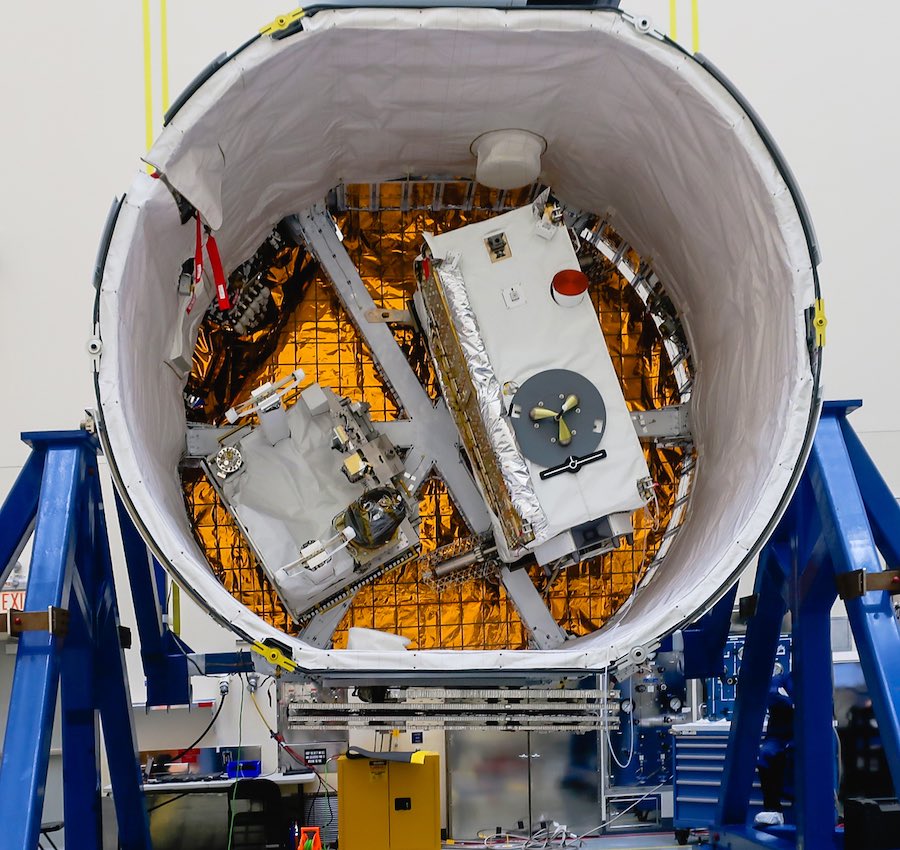 |
|
SpaceX Dragon CRS-17 mission truck carrying two
payloads including NASA’s Orbiting Carbon Observatory-3 (OCO-3) and the U.S. military’s Space Test Program-Houston 6 (STP-H6) payloads. Credit: NASA |
onsite coverage of NASA, SpaceX, ULA, Boeing, Lockheed Martin, Northrop Grumman
and more space and mission reports direct from the Kennedy Space Center, Cape
Canaveral Air Force Station, Florida and Wallops Flight Facility, Virginia.
Stay tuned here for Ken’s continuing Earth and
Planetary science and human spaceflight news: www.kenkremer.com –www.spaceupclose.com – twitter @ken_kremer
– email: ken at kenkremer.com
Dr. Kremer is a research scientist and journalist based in the
KSC area, active in outreach and interviewed regularly on TV and radio about
space topics.
………….
Ken’s photos are for sale and he is available for lectures and outreach events
Heavy, SpaceX Demo-1 launch/test failure, SpaceX Beresheet launch, NASA missions, ULA Atlas & Delta launches,
Northrop Grumman Antares, SpySats and more at Ken’s upcoming outreach events at
Quality Inn Kennedy Space Center,
Titusville, FL, evenings:
May
2/3/4: “SpaceX Falcon 9 CRS-17
resupply launch to ISS, Demo-1, Beresheet launches, SpaceX Falcon Heavy launches, upcoming SpaceX Falcon 9, ULA, NRO
& USAF Spysats, SLS, Orion, Boeing and SpaceX Commercial crew capsules,
OSIRIS-Rex, InSight Mars lander, Curiosity and Opportunity explore Mars, NH at
Pluto, Ultima Thule and more,” Kennedy Space Center Quality Inn, Titusville,
FL, evenings. Photos for sale


